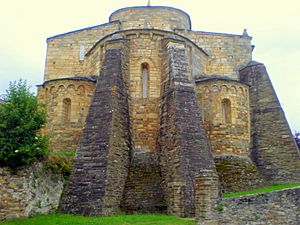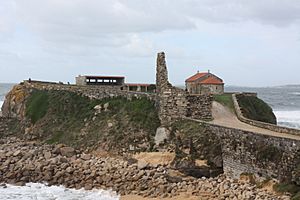Vikings in Iberia facts for kids

Vikings started visiting the Iberian Peninsula (modern-day Spain and Portugal) around the mid-800s. They were already raiding and setting up bases in Frankia (modern France) before this. While Vikings had strong connections with lands to the east, like the Islamic world through the Rus' people, their visits to Western Europe were less common.
There's no proof that Vikings lived or traded in Iberia for long periods. They might have stayed through winter sometimes. The area might not have been a very rich target for raids in the 800s and 900s. However, Vikings continued their raids until the end of the Viking Age. Most of what we know about Vikings in Iberia comes from old written stories. Some archaeological finds, like possible ship anchors or mound shapes near rivers, might show where Viking ships docked.
Contents
What Vikings Were Called
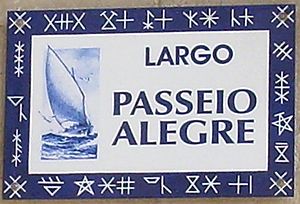
In old Latin writings from Iberia, Vikings were often called normanni, which means 'northmen'. They were also called gens normannorum or gens nordomannorum, meaning 'people of the northmen'. Sometimes, these names changed a bit, like lordomanni.
In Arabic writings, Vikings were called majūs. This word was used for many different non-Muslim people, so it didn't always mean Vikings specifically. However, a famous Arabic writer, Al-Mas‘ūdī, said that the raiders who attacked Seville in 844 were partly Rūs and al-lawdh’āna. These names likely pointed to Scandinavian Vikings.
First Viking Raid in 844
The first major Viking attack in Iberia happened in August 844. A group of Vikings, who had been raiding in France, sailed into the Garonne river and reached Galicia. Even after a storm damaged some ships, others continued to southwest Spain.
Old Latin and Arabic records confirm this event. The Chronicle of Alfonso III says that after looting coastal villages, the Vikings were stopped near the Tower of Hercules. King Ramiro I of Asturias gathered his troops and fought back. After the Asturian army won, the Vikings sailed on towards Lisbon.
Later Arabic writings, especially from Ibn al-Qūṭiyya, give more details. It seems clear that after raiding Galicia and Asturias, the Vikings went south. They attacked Lisbon and then Seville.
A local legend in Galicia tells a story about the Vikings arriving at the Masma river. Bishop Gonzalo prayed for help, and a big storm sank most of the Viking ships. Only one ship escaped to warn the rest. Some old castles along the Galician coast might have been lookouts or shelters built by locals against Viking raids.
Second Raid (859-861)
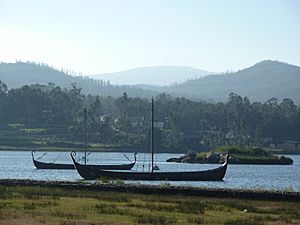
Vikings returned to Galicia in 859. This seems to have been a three-year campaign during the time of King Ordoño I of Asturias. Most of our information comes from Arabic histories written by Ibn Ḥayyān. Some Latin writings from that time also mention these events.
Historians believe this expedition, like the one in 844, involved a single group of adventurers. They tried raiding northern Iberia and al-Andalus again but didn't have much success. So, they sailed into the Mediterranean Sea to raid other places. They might have captured people to sell as slaves or for ransom.
It's thought that these Vikings might have spent the winter in France. They may have waited for good weather to sail out of the Mediterranean through the Straits of Gibraltar. Some stories even suggest they sailed to Italy, Alexandria, or Constantinople, but this is not certain.
Raids in the 960s and 970s
There isn't much information about Viking activity in Iberia for almost a century after 861. However, several sources, including writings from Dudo of Saint-Quentin and Arabic historians, show that Vikings did raid Iberia in the 960s and 970s.
One story from the Chronicle of Sampiro describes a raid in 968. A fleet of a hundred ships, led by a Viking named Gundered, arrived to plunder Iria. Bishop Sisnando Menéndez fought them but was killed in battle. The Vikings spent three years destroying and looting the land. They were finally defeated by Gonzalo Sánchez in the Cebreiro mountains. Bishop Sisnando had built defenses around Santiago de Compostela to protect it from Vikings and other enemies.
Some old Galician documents from later decades talk about the destruction of monasteries. They call these times "dies Lordemanorum," meaning "day of the Northmen." One document from 996 even uses the location of an old Viking fortress as a landmark.
According to Ibn Idhārī, Lisbon was raided again by Vikings in 966. This time, they had 28 ships but were successfully pushed back. He also wrote about more raids in Al-Andalus in 971–972.
Raids in the 1000s
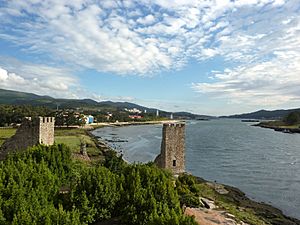
Viking raids in Iberia continued into the early 1000s. A 12th-century record mentions Viking raids in 1008 and 1016. The Heimskringla saga says that Olaf II of Norway, who later became king, raided Iberia in 1015 on his way to Jerusalem. He attacked places like Castropol and Tui.
Even though these stories might not be fully accurate, a document from 1015 tells a real story. A man named Amarelo Mestáliz sold land to pay a debt. He had to pay a ransom to Vikings to get his three daughters back. The document says: "A large number of Vikings arrived in July. They stayed for nine months between the Douro and Ave rivers. These Vikings captured my three daughters, Serili, Ermesenda, and Faquilo. I became poor because I had to pay the Vikings silver to get them back."
A few years later, a Viking ship demanded a cloak, a sword, a shirt, linen, a cow, and salt as ransom for a woman and her daughter.
In 1024, King Alfonso V of León joined the bishopric of Tui to Santiago. This was because Tui had been destroyed by the "gens Leodemanorum" (Vikings). The local Bishop and many others were captured and taken away, while others were sold or killed.
In 1068, Bishop Cresconius of Iria strengthened Santiago's defenses. He also rebuilt castles like the Torres de Oeste and the fortress of A Lanzada. These were built to protect the sea routes to Compostela. This shows that Vikings were still seen as a threat.
As the Viking Age ended, Scandinavians and Normans still visited and raided Iberia. They often did this on their way to the Holy Land for pilgrimages or crusades.
Vikings in Madeira
Scientists found small pieces of mouse bone from the 900s or 1000s in Madeira. The DNA of mice in Madeira today also suggests that Vikings came to the island. They likely brought mice with them before the Portuguese settled there.
Many historians think that Viking activity helped lead to the building of navies and forts in Iberia. This happened during the 900s and 1000s. For example, some believe the first navy of the Emirate of Córdoba was built because of the 844 raid. Also, King Alfonso III of León was worried about Viking attacks. He built strong forts near the coast, just like other rulers were doing.
However, many other things also encouraged these developments. It's clear that the growth of navies and forts wasn't just because of Viking raids.
See also
 In Spanish: Vikingos en la península ibérica para niños
In Spanish: Vikingos en la península ibérica para niños


